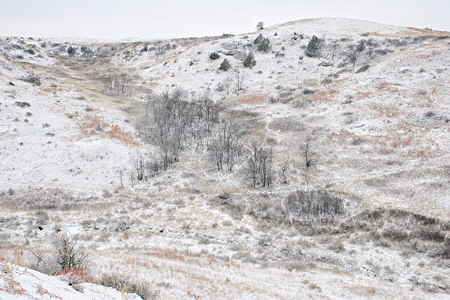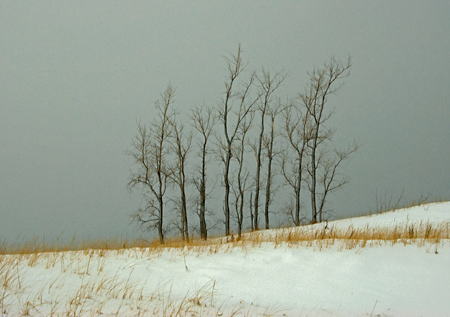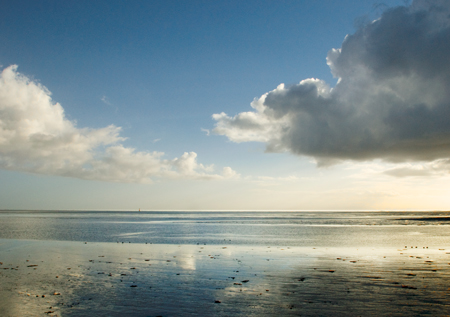Posted by Steve Durbin on March 4th, 2008
Seems like everybody is making a book these days. Lower prices and improvements in quality have made publish-on-demand an intriguing proposition. Reviews are mixed, but I’ve reached the point where I’m interested in giving it a try. Since I tend to work in projects, there are several bodies of work that are candidates for books. I’ve decided to look first at the smallish number of images in the set I’ve called Winter Water, some of which have been placed on my not up to date web site, or discussed here and there on A&P.
A book is necessarily presented as a linear sequence of pages, though a reader (is it still a reader if there are only photographs?) may not follow that order. Nevertheless, assuming one image per page for maximum resolution, it’s an interesting question to consider what sequence might work best. It’s akin to hanging pictures in an exhibit. As I am neither illustrating a narrative nor providing a guide to Pine Creek Falls in Paradise Valley in late November, I am not bound by the order in which the photographs were made or the physical layout of the falls. Considerations include interesting pictorial relationships, pacing, and the overall impression desired. None of these is at all well-defined, and I come up with a different order every time I sit down to it. I make no claims for the latest version shown below; in fact, I’m asking for your help.
more… »
Posted by Steve Durbin on February 29th, 2008

A while ago I posted some first thoughts on personal psychogeography, including the germ of a project involving photography and writing. I’m grateful to comments (from Martha and Lucy) for pointing me to significant related work by Richard Long, Hamish Fulton (beware annoying Flash), and Francesco Careri. These have been helpful to me in formulating my own project, which is, in fact, very different. I am approaching the idea — call it a psychogeographic study — primarily as a photographer, i.e. one interested in making photographs. In contrast, Long and Fulton (and the architect Careri, from the little I know) consider their photographs quite secondary: the walk itself is the artwork.
more… »
Posted by Birgit Zipser on February 27th, 2008
as we are told in yesterday’s headline of the Columbia Daily Spectator reporting on the opening of an HBO documentary reminding us of the long gestation of Christo and Jeanne-Claude’s Saffron Gates in Central Park, New York City?
Or does Saffron spell enthusiasm? Here is my snapshot of Saffron cloth billowing in the wind on a snow-free day, February 2005.

more… »
Posted by Birgit Zipser on February 22nd, 2008
After musing for decade or so on how to capture this solitary stand of cottonwoods growing on a ridge in the dunes, the challenge was met through dérive or drifting.

more… »
Posted by Steve Durbin on February 19th, 2008
Among the first images I captured after purchasing my digital camera were made on a trip to the Yucatan peninsula of Mexico. I was drawn mainly by the Mayan ruins there, having had a particular interest in things Maya since a college anthropology class. Though terrific in some ways, photographically the trip was not a success. Although I wrote last week of re-visiting and revising old images, there’s no point if the original lacks merit. I did not know my new equipment well, I didn’t understand picture-making very well, and though I knew I wanted to work in black and white, I hadn’t yet developed an eye for it.

more… »
Posted by Steve Durbin on February 14th, 2008
When it comes to created work, most artists have little choice but to move on once they’ve produced a piece (admittedly, it can sometimes be difficult to identify or reach an endpoint). Photographers are blessed or cursed with a real choice. Probably most, having once achieved a satisfactory rendition of an image, are willing to leave it there. From that point, with digital technology, endless identical copies can be made (I’m ignoring printing technicalities, a different subject altogether). In the non-digital world of printing from negatives, a new print request may entail a repeat visit to the darkroom, but careful photographers certainly have notes on paper choice, development time, and any dodging or burning they might have settled on. Reproducibility is one of photography’s greatest strengths, despite the headaches and posturing over pricing that it may induce.

more… »
Posted by Birgit Zipser on February 8th, 2008
Personal psychogeography (see previous post) has provided food for thoughts for many days to come. Listening to Will Self’s lecture on this subject, I enjoyed the image of a busy novelist who, intellectually, made the decision to allow ‘drift’ into his own life. He explained that he used to live in ‘microenvironments’ consisting of the city of London and, on his book tours, the hotels that he was transported into by airplanes and taxis. To appreciate more of his surroundings, he now walks from airports to hotels or takes buses.
I, too, find it more enjoyable to take a bus from La Guardia airport through the streets of Queens to Manhattan. Part of my enjoyment is watching the ethnicity of people boarding or leaving the bus in the different neighborhoods. Psychogeography accompanied by anthropology, an interest in the lives of people?
First of all, a common thread in my personal psychogeography has been Water. Having grown up in a small town at the North Sea, I often jogged with my dog along a bay in the ocean.

more… »





